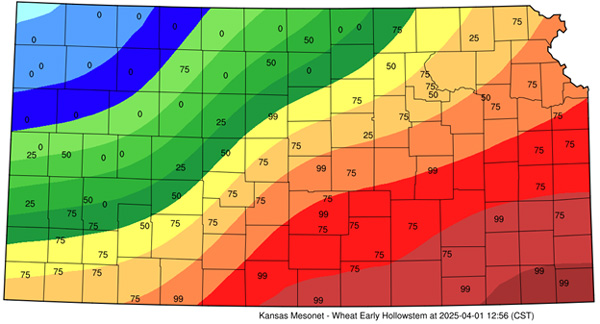Cattle should be removed from wheat pastures when the crop reaches first hollow stem (FHS). Grazing past this stage can severely affect wheat yields. For a full explanation, please refer to the companion article in this eUpdate, “Optimal time to remove cattle from wheat pastures: First hollow stem.”
First hollow stem update
To screen for FHS during this important time in the growing season, the K-State Extension Wheat and Forage's crew measure FHS on a weekly basis in 16 different commonly grown wheat varieties in Kansas. The varieties are in a September-sown replicated trial at the South Central Experiment Field near Hutchinson.
Ten stems are split open per variety per replication (Figure 1), for a total of 40 stems monitored per variety. The average length of the hollow stem is reported for each variety in Table 1. As of March 31, all varieties evaluated in this trial had reached first hollow stem.

Figure 1. Ten main wheat stems were split open per replication per variety to estimate first hollow stem for this report, for a total of 40 stems split per variety. Photo by Romulo Lollato, K-State Research and Extension.
Table 1. Length of hollow stem measured between February 17 and March 31, 2025, of 16 wheat varieties sown mid-September 2024 at the South Central Experiment Field near Hutchinson. The critical FHS length is 1.5 cm (about a half-inch or the diameter of a dime). Value(s) in bold indicate the highest FHS group.
|
|
First Hollow Stem (cm) |
||||||
|
Variety |
2/17 |
2/24 |
3/6 |
3/10 |
3/17 |
3/24 |
3/31 |
|
AP Sunbird |
0 |
0 |
0 |
0.00 |
0.41 |
0.89 |
7.54 |
|
AP24 AX |
0 |
0 |
0 |
0.03 |
0.70 |
1.58 |
5.15 |
|
AR Iron Eagle AX |
0 |
0 |
0 |
0.06 |
0.44 |
0.95 |
5.67 |
|
AR Turret 25 |
0 |
0 |
0 |
0.04 |
0.51 |
1.50 |
4.42 |
|
CLH10-153.022 |
0 |
0 |
0 |
0.00 |
0.37 |
1.18 |
3.81 |
|
CLH10-1853.014 |
0 |
0 |
0 |
0.03 |
0.37 |
1.08 |
4.60 |
|
CP7017AX |
0 |
0 |
0 |
0.01 |
0.50 |
1.04 |
4.77 |
|
CP7869 |
0 |
0 |
0 |
0.03 |
0.29 |
1.10 |
5.31 |
|
Kivari AX |
0 |
0 |
0 |
0.09 |
0.58 |
1.74 |
4.34 |
|
KS Ahearn |
0 |
0 |
0 |
0.01 |
0.34 |
0.85 |
3.90 |
|
KS Bill Snyder |
0 |
0 |
0 |
0.00 |
0.29 |
1.07 |
2.73 |
|
KS Mako |
0 |
0 |
0 |
0.02 |
0.35 |
0.90 |
4.49 |
|
KS Providence |
0 |
0 |
0 |
0.01 |
0.55 |
1.01 |
5.08 |
|
KS Territory |
0 |
0 |
0 |
0.00 |
0.29 |
0.73 |
3.09 |
|
KS21H36 |
0 |
0 |
0 |
0.01 |
0.22 |
0.69 |
4.06 |
|
Sheridan |
0 |
0 |
0 |
0.01 |
0.35 |
1.75 |
4.03 |
Since all varieties have already reached the first hollow stem stage, this will be the last report for the 2024-25 growing season. We note that some fields in north-central or northwest Kansas may not yet have reached first hollow stem (Figure 2) and therefore we advise producers in those areas to closely monitor their fields to make the decision about when to remove cattle from wheat pastures.
First Hollow Stem Tracking Tool on the Kansas Mesonet
The Kansas Mesonet has a tool to help track wheat development: Wheat First Hollow Stem (https://mesonet.k-state.edu/agriculture/wheat/hollowstem/). This page tracks soil temperature to calculate wheat growing degree days (GDD) associated with first hollow stem occurrence. This tool employs a wheat growth model developed by Oklahoma State University and the Oklahoma Mesonet, which was validated for wheat growing conditions experienced in south-central Kansas during the 2016-2021 growing seasons. The output of the model provides the probability of first hollow stem occurrence (current and historical) both for early- and late-maturing wheat varieties. A detailed description of this tool is available at https://eupdate.agronomy.ksu.edu/article/wheat-growth-and-development-tool-for-estimating-first-hollow-stem-534-2.

Figure 2. Values represent the percent probability of first hollow stem occurrence for early maturing varieties. Source: Kansas Mesonet.
The intention of this report is to provide producers with an update on the progress of first hollow stem development in different wheat varieties. Producers should use this information as a guide. Still, it is extremely important to monitor FHS from an ungrazed portion of each individual wheat pasture to make the decision to remove cattle from wheat pastures.
Contact author:
Romulo Lollato, Wheat and Forages Specialist
lollato@ksu.edu
Chip Redmond, Kansas Mesonet
christopherredmond@ksu.edu
Luiz Otavio Pradella, PhD Student
Jazmin Gastaldi, Master Student